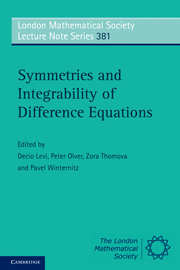Book contents
- Frontmatter
- Contents
- List of figures
- List of contributors
- Preface
- Introduction
- 1 Lagrangian and Hamiltonian Formalism for Discrete Equations: Symmetries and First Integrals
- 2 Painlevé Equations: Continuous, Discrete and Ultradiscrete
- 3 Definitions and Predictions of Integrability for Difference Equations
- 4 Orthogonal Polynomials, their Recursions, and Functional Equations
- 5 Discrete Painlevé Equations and Orthogonal Polynomials
- 6 Generalized Lie Symmetries for Difference Equations
- 7 Four Lectures on Discrete Systems
- 8 Lectures on Moving Frames
- 9 Lattices of Compact Semisimple Lie Groups
- 10 Lectures on Discrete Differential Geometry
- 11 Symmetry Preserving Discretization of Differential Equations and Lie Point Symmetries of Differential-Difference Equations
- References
3 - Definitions and Predictions of Integrability for Difference Equations
Published online by Cambridge University Press: 05 July 2011
- Frontmatter
- Contents
- List of figures
- List of contributors
- Preface
- Introduction
- 1 Lagrangian and Hamiltonian Formalism for Discrete Equations: Symmetries and First Integrals
- 2 Painlevé Equations: Continuous, Discrete and Ultradiscrete
- 3 Definitions and Predictions of Integrability for Difference Equations
- 4 Orthogonal Polynomials, their Recursions, and Functional Equations
- 5 Discrete Painlevé Equations and Orthogonal Polynomials
- 6 Generalized Lie Symmetries for Difference Equations
- 7 Four Lectures on Discrete Systems
- 8 Lectures on Moving Frames
- 9 Lattices of Compact Semisimple Lie Groups
- 10 Lectures on Discrete Differential Geometry
- 11 Symmetry Preserving Discretization of Differential Equations and Lie Point Symmetries of Differential-Difference Equations
- References
Summary
Abstract
In these lectures we take a look at various meanings of integrability for difference equations, and the possibility of algorithmic methods to identify (partial) integrability. Analogies with continuum equations are used when possible, but the world of discrete equations is richer and many new things enter.
Preliminaries
Points of view on integrability
One can approach the integrability of dynamical equations from two opposite directions:
Top down: In this approach one first chooses some high level mathematical structure and then derives its consequences/manifestations for dynamical equations. The underlying mathematical structure is there from the start and therefore as a result one gets a method for generating equations with good properties.
Bottom up: In this case the equation is given, for example: “In my application I found this equation, what can you say about it?” In order to answer questions of this type we need a toolbox of (algorithmic) methods that can be applied. With them we can, hopefully, identify the equation or at least say whether it is integrable or partially integrable or chaotic. If the equation is at least partially integrable we may be able to say something about its structure, construct some solutions, conserved quantities etc. And although complete integrability itself is structurally unstable, many properties persist in nearby non-integrable systems, and one can try a perturbative expansion around the integrable one.
- Type
- Chapter
- Information
- Symmetries and Integrability of Difference Equations , pp. 83 - 114Publisher: Cambridge University PressPrint publication year: 2011
References
- 5
- Cited by

